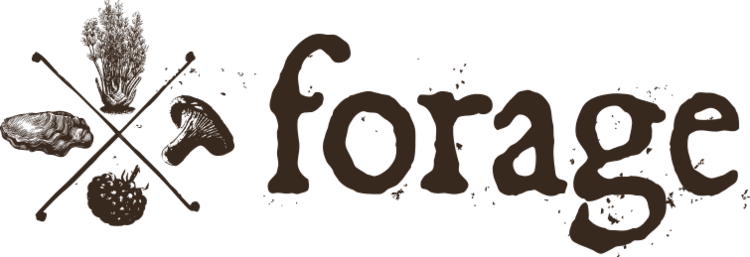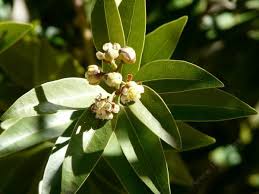California Bay: Don't Buy Bay, forage it!
Todays guest post is from my all time favorite favorite foraging book, The Flavors of Home. This amazing book, written by Margit-Roos Collins, is my go to on foraging for wild edibles in The Bay, and I highly recommend it to anyone who wants to learn about what nature has to offer in our area (I like it so much I even wrote the forward for the new edition!). Check out her post below and make sure to click the link at the bottom to get a copy of your own with a special discount.
Happy foraging!
Iso Rabins
Founder: forageSF
California Bay, California Laurel, or Bay Laurel
(Umbellularia californica)
On the spice shelves in supermarkets you can find jars marked "California Bay Leaves" and buy them for use in cooking. Or you can pick them for free on your next hike.
Bay leaves. We cook with them so often, adding their spicy aroma to stews, soups, pot roasts, and tomato sauces. How pleasant it is to be able to pick our own in woods all over the Bay Area! I love to pinch off a leaf and enjoy its fragrance as I walk along a trail. Hold them at least a few inches from your face. Before I knew better, I crushed them right under my nose to get a full whiff. The strong oils exploded in my sinuses, with the same sensation as getting water up my nose when swimming.
Bay trees are easiest to identify by using your nose. If you study the smell of a commercial bay leaf, you will easily recognize the same odor in the woods. The dark green leaves are several inches long and thin. They have a prominent vein up the center, are smooth edged, and are rather tough.
The trees often cluster together in groves, particularly along streams and on the steep slopes above them. They always grow directly up toward the light; if one falls over but remains alive, its branches on the sky side will thicken and develop into a row of mini-trees. A bay grove is a grey-green, somewhat mysterious place. The trees grow so densely that the light is heavily filtered and there's little undergrowth. Add a few Douglas firs with their licheny bark, a twisted live oak, and some giant ferns, and you have the classic California coastal forest -- a setting made for fairy tales.
Our native bay leaves are more aromatic than the ones usually sold for cooking, Laurus nobilis from the Mediterranean and red bay from our Atlantic and Gulf Coasts. Authorities on wild-food plants generally suggest using half as much California bay as you would of other bay leaves. However, most cookbooks are so timid about seasonings that I've had no trouble using them in the amounts called for.
The old way to dry bay leaves for use in cooking was to break off a branch, tie it upside down in a dry spot, and pick off the leaves when they were ready. However, one era's acceptable behavior becomes another era's vandalism. Rather than taking a branch, simply pick as many mature leaves as you need, spread them out on a flat surface covered with a paper towel, and let them dry for a few days before putting them in an airtight container. Remember that all herbs lose flavor with time, and your food will taste better if you prepare a fresh supply of bay leaves at least once a year. I like to bring home 10 or 12 leaves, which I can dry on a plate without making a big production of it. Those last me a few months and then I harvest another pocketful.
Some people make beautiful wreaths of bay laurel leaves for winter holiday decorations and then enjoy them in their kitchens the rest of the year, gradually using up the leaves for cooking. The ancient Greeks also thought laurel wreaths were lovely and made them into garlands for victorious athletes; because of that custom, the word laurels has become a synonym for praise and honors.
The leaves have another useful property in addition to their flavor. Quite simply, insects hate their smell. You can use this to your advantage when you want to keep flies away from a picnic or from food near an open window; just put a few leaves around the dishes. If your cat or dog has fleas, scattering bay leaves around the yard is said to drive them away. Alternately, stringing a few leaves onto a pet's collar should also do the trick, if the animal's sensitive nose can stand it.
Insect-repellant properties are fine in a plant until it needs to reproduce. Then there's a conflict. Bays, like most advanced plants, bloom and then need insects to carry pollen from one flower to the ovaries of another flower, thereby fertilizing it so that a new bay nut can grow, drop off, and start a new bay tree. But as long as the bugs can smell the leaves, they avoid the trees.
Perhaps bays could have evolved to avoid this problem by spreading their pollen on the wind. Fortunately for us, they went another route. Their flowers developed a jasmine fragrance so powerful that when a branch is in full bloom, the odor of the leaves is completely masked.
The trees can start blooming as soon as the end of November in a year with early rains, along the ridges near the coast. By January, most trees, even in the colder East Bay, have some blossoms open. But a warm mid-February day is by far the best time to smell them. Walk along trails on still, sunny days and as you enter a grove of bay trees, the fragrance will fill the air.
If you go a little too early, or on a cold day, or walk in a shady place, you will be able to smell the flowers only by putting your nose right up to them. I've had the best luck in East Bay parks where the trail led through a sunny hillside grove or along a broad valley where the trees received lots of warmth. One great spot is in Briones Park on the Abrigo Valley Trail, just beyond the Bear Creek entrance and picnic area.
In late summer, you will begin to see hard, green fruits on the bays. By October, they are ripe all over the Bay Area, and the green fruit becomes soft and darkens to a purple color. At that point, the fruit is edible, with a taste and texture somewhat similar to avocado. After the bay fruits fall to the ground, the soft exterior rots away, exposing a hard nut inside. The Indians used to eat roasted bay nuts with meals and on strenuous journeys, comparing them to our coffee.
The nuts are full of pungent oils. Biting into a raw one is like biting into a fresh bay leaf -- extremely strong tasting. Just as insects avoid the leaves, the usual nut-eating creatures seem to avoid the nuts. I was able to collect several dozen in December, after they'd been on the ground several months, and when I got them cleaned and shelled, I was amazed to see that not one had any worm holes or bugs or blemishes of any kind. In that respect, at least, they are a forager's dream food. Their shells come off easily, revealing two pale green halves. Try baking the shelled nuts at 350° F. for about half an hour until they are a rich brown color and crunchy. The baking modifies their bitterness and makes it not only bearable but also mildly interesting. Taste them in small bits.
I had notions of leaching out the bitterness, baking them until they were dry, and producing a delicacy, but this failed. The first two changes of boiling water turned a very unnatural (though beautiful) pale aquamarine, the third bath turned forest green, and in the end the nuts were just as bitter as before and mushy. Stick to baking them.
Where and When to Find It
Bay trees are obligingly common. Their natural range is the entire California and Oregon coast and the Sierra Nevada. In the Bay Area, you will find them in most forests, except in the most eastern areas, such as Black Diamond Mines and the region northeast of Mt. Diablo. Trees along streams bear more nuts than ridgetop bays. The blooming period is normally from December through March, but mid-February is definitely the time to visit a bay grove if you want the full effect of their fragrance. Those questionable nuts can be harvested from at least October through mid-winter. Best of all, the leaves are available year round.



